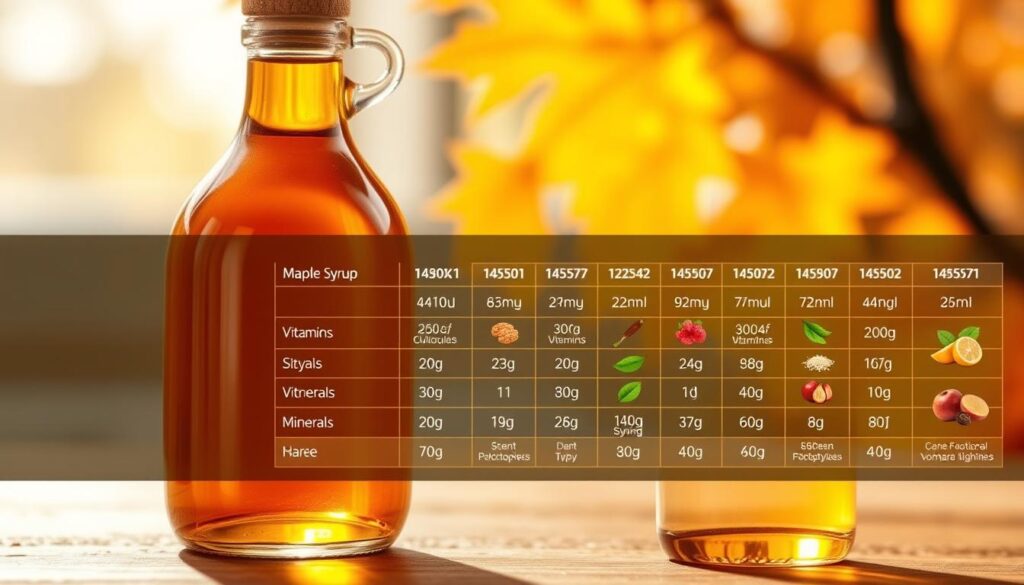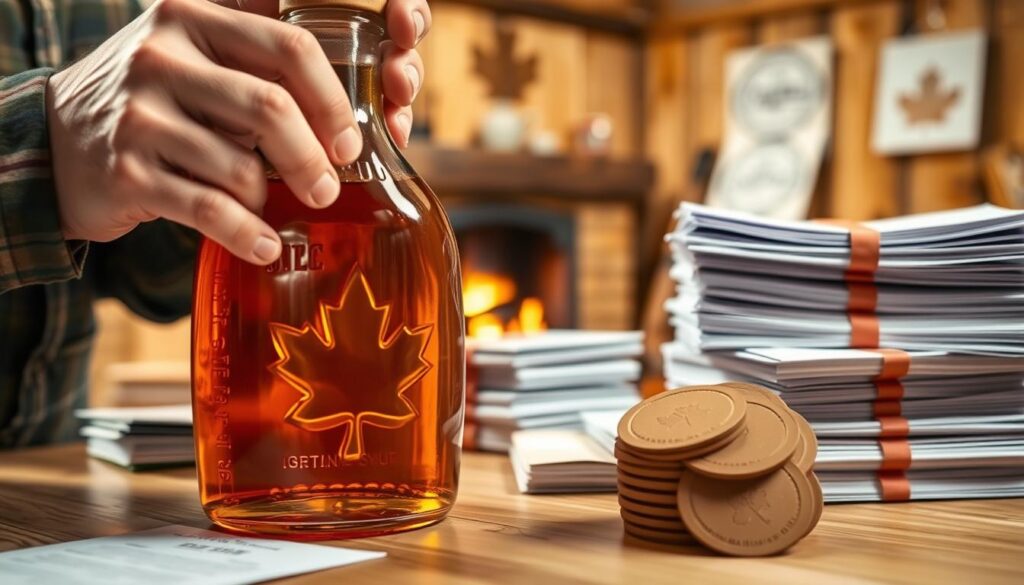Looking for a healthier sweetener can change how you cook. Maple syrup is a great choice, with amazing flavor and health benefits. It’s made by skilled sugarmakers in North America, giving you a natural way to sweeten your food.
Many are moving away from corn syrup to natural sweeteners. Maple syrup is a top choice because it tastes great and is good for you. It has a rich flavor and lots of minerals, making it a smart pick for cutting down on processed sugar.
The process of making maple syrup is interesting and rooted in North American traditions. Sugarmakers tap maple trees in late winter to get sap. This sap turns into a sweetener full of nutrients. It’s a better choice than corn syrup, adding real taste and health benefits to your meals.
Experts say maple syrup is a better sweetener than corn syrup. It has minerals like manganese, zinc, and calcium. Each spoonful connects you to sustainable farming and old harvesting methods that focus on quality and care for the environment.
Choosing maple syrup over corn syrup means you’re picking a natural, nutritious sweetener. Your dishes will taste amazing and help you eat healthier. Plus, you’ll support traditional farming ways.
Understanding Maple Syrup: Nature’s Golden Sweetener
Organic maple syrup is a natural sweetener with deep roots in North America. It comes from the sap of maple trees. This process turns simple sap into a rich, tasty treat.
Maple syrup is more than just sweet. It has natural compounds that make it special. This sets it apart from other sweeteners.
Chemical Composition and Natural Properties
Maple syrup’s makeup is full of nutrients and minerals. It includes:
- Sucrose: The main natural sugar
- Trace minerals like zinc and manganese
- Antioxidants and polyphenols
- Amino acids and organic compounds
Traditional Harvesting Methods
For generations, sugarmakers have collected maple sap. The traditional steps are:
- Choosing mature maple trees
- Drilling small holes
- Collecting sap in spring
- Boiling the sap carefully
“Maple syrup is nature’s purest sweetener, crafted with patience and respect for the forest.” – Traditional Sugarmaker
Processing and Grade Classifications
Organic maple syrup is sorted into different grades. These are based on color, flavor, and light. The grades range from light and mild to dark and strong.
| Grade | Color | Flavor Profile |
|---|---|---|
| Golden | Light | Mild, delicate |
| Amber | Medium | Rich, balanced |
| Dark | Deep | Strong, pronounced |
Each grade of maple syrup has its own benefits. This makes it great for many recipes.
The Health Risks of Corn Syrup Consumption
Corn syrup has become a topic of debate in today’s diets. Many are looking for safer sweeteners. The health risks of high-fructose corn syrup worry doctors and nutritionists.
Some health risks of too much corn syrup include:
- Increased risk of metabolic syndrome
- Potential liver damage from high fructose intake
- Higher chances of developing insulin resistance
- Accelerated weight gain
- Potential cardiovascular complications
Research shows corn syrup is different from other sugars. The body processes fructose directly in the liver. This can cause fat buildup and disrupt metabolism. It’s hard to keep blood sugar levels healthy with corn syrup.
People looking for a Glucose-Free Sweetener are choosing natural options like maple syrup. Maple syrup has nutrients and doesn’t raise blood sugar as much. This shows a growing interest in healthy eating.
Nutritional experts recommend limiting processed sugar intake and exploring natural sweetening alternatives that support overall wellness.
Knowing these risks helps people make better food choices. They can pick healthier sweeteners for their health in the long run.
Why Choose Maple Syrup as Corn Substitute
Finding a healthier sweetener can change how we eat. Maple syrup is a great choice, with many benefits beyond just being sweet.
People looking for a Diabetic-Friendly Syrup often choose maple syrup. It has a special nutritional profile that corn syrup doesn’t match.
Nutritional Powerhouse
Pure maple syrup is full of nutrients, unlike processed corn syrup. Here’s how they compare:
- Rich in antioxidants
- Contains trace minerals like zinc and manganese
- Lower in total sugar content
- Minimal processing compared to corn syrup
Glycemic Index Advantages
The glycemic index shows maple syrup’s health benefits. Pure maple syrup has a lower glycemic impact. This makes it better for those watching their blood sugar.
“Nature’s sweetener offers more than just flavor – it provides real nutritional value,” says nutrition expert Dr. Sarah Thompson.
Environmental Considerations
Maple syrup production is good for the environment. Sugarmakers harvest syrup from living trees, helping forests.
- Minimal environmental footprint
- Supports forest conservation
- Renewable resource
- Traditional harvesting methods
Choosing maple syrup is good for your health and the planet. Its natural origins and nutrients make it a better choice than corn syrup.
Essential Nutrients and Minerals in Pure Maple Syrup

Pure maple syrup is a natural sweetener full of nutrients. Unlike many sweeteners, it offers real health benefits. It’s a golden liquid that’s packed with essential nutrients.
Maple syrup is a standout natural sweetener. It has several key minerals and compounds:
- Manganese: Supports bone health and metabolism
- Zinc: Boosts immune system function
- Calcium: Promotes strong bones and teeth
- Potassium: Helps regulate blood pressure
- Antioxidants: Fights cellular damage
Maple Syrup Benefits go beyond just being sweet. Researchers found that it has up to 24 different antioxidants. These help protect the body from damage. Darker maple syrup grades have more of these health-protecting compounds.
Maple syrup is a better choice than refined sugars. It’s packed with trace minerals. This makes it a great option for those who want taste and nutrition. Its complex makeup offers real health benefits, unlike processed sugar alternatives.
One tablespoon of pure maple syrup contains more nutritional value than many refined sweeteners combined.
Nutritionists say to choose pure, unprocessed maple syrup for the best health benefits. By picking high-quality, minimally processed syrup, you get a sweetener that’s good for you. It supports your overall wellness.
Converting Corn Syrup to Maple Syrup in Recipes
Changing recipes from corn syrup to maple syrup needs careful thought. Maple syrup is a tasty Corn Syrup Alternative. It can make both sweet and savory dishes better with its natural flavor.
Measurement Guidelines
When swapping maple syrup for corn syrup, knowing the right amounts is key. Here are some important tips:
- Use a 1:1 ratio for most liquid-based recipes
- Reduce other liquid ingredients by 2-3 tablespoons per cup of maple syrup
- For baking, decrease oven temperature by 25°F to prevent over-browning
Texture and Consistency Adjustments
Maple Syrup as Corn Substitute needs some texture changes. Maple syrup is thicker than corn syrup, so recipes might need tweaks.
- Add 1/4 teaspoon of cornstarch per cup of maple syrup for thickening
- Expect a slightly more robust flavor profile
- Use lighter-grade maple syrups for delicate recipes
Temperature Considerations
Cooking with maple syrup requires watching the heat. Maple syrup’s natural sugars caramelize quicker than corn syrup, so temperature control is important.
- Monitor cooking temperatures closely
- Use medium-low heat for most recipes
- Stir frequently to prevent burning
Pro tip: Start with recipes that naturally complement maple’s rich flavor, such as baked goods and glazes, for the most successful substitution.
Baking with Maple Syrup: Tips and Techniques

Using maple syrup in baking opens up a world of tasty possibilities. This golden liquid adds more than sweetness. It brings depth and complexity to your recipes.
When baking with maple syrup, knowing a few key techniques is important. It’s great as a pancake topping and in baking. Here are some tips:
- Reduce liquid ingredients by about 1/4 cup for every cup of maple syrup used
- Lower oven temperature by 25 degrees to prevent over-browning
- Add 1/4 teaspoon of baking soda to help balance the syrup’s acidity
Some baked goods pair well with maple syrup. Muffins, cookies, and quick breads become moist and flavorful. This natural sweetener replaces traditional sugar well.
Experts suggest starting with recipes made for maple syrup. Start slow, as it behaves differently from sugar. Be patient and ready to adjust your methods.
“Maple syrup isn’t just a topping – it’s a transformative baking ingredient that can elevate even the simplest recipes.” – Artisan Baker’s Handbook
When substituting maple syrup, precision is key. Use 3/4 cup of maple syrup for every 1 cup of sugar. Adjust other liquids as needed.
Maple Syrup in Vegan and Plant-Based Cooking
Maple syrup is a key natural sweetener in vegan and plant-based cooking. It’s loved by home cooks and chefs for its rich taste and health benefits. It’s perfect for vegan baking and making dairy-free recipes.
Innovative Egg Replacement Techniques
Vegan baking needs new ways to replace eggs, and maple syrup helps. It can:
- Bind ingredients in baked goods
- Add moisture to plant-based recipes
- Make things sweeter without using refined sugars
Dairy-Free Culinary Applications
Maple syrup is great for more than just baking. It’s used to make tasty dairy-free foods. Chefs use it in many plant-based dishes.
| Dairy-Free Application | Maple Syrup Usage |
|---|---|
| Vegan Ice Cream | Sweetener and flavor enhancer |
| Plant-Based Milk Alternatives | Natural flavor booster |
| Smoothie Bases | Liquid sweetener replacement |
Professional vegan chefs love maple syrup. They see it as a natural sweetener that makes plant-based dishes richer. It’s a must-have for modern vegan baking.
Cost Comparison: Maple Syrup versus Corn Syrup
When looking at Maple Syrup as a Corn Syrup Alternative, price is a big factor. Pure maple syrup is much pricier than corn syrup. This is because making maple syrup is a complex process.
The cost of maple syrup comes from several things:
- Labor-intensive harvesting methods
- Limited geographical production regions
- Seasonal collection windows
- Artisanal processing techniques
“Quality comes with a price, and maple syrup exemplifies this principle” – Maple Producers Association
Looking at the costs, we see some key points for those wanting a Corn Syrup Alternative:
| Sweetener Type | Average Price per Gallon | Production Complexity |
|---|---|---|
| Corn Syrup | $5-$8 | Industrial |
| Pure Maple Syrup | $40-$60 | Artisanal |
Maple syrup might seem expensive at first. But its health benefits and unique taste make it worth it for those who care about their health.
Storage and Shelf Life of Natural Maple Syrup
Keeping organic maple syrup quality up requires the right storage. The right care keeps its flavor and nutrients for longer.
Knowing how to store maple syrup well can make it last longer. Experts say to follow certain steps to keep it fresh.
Selecting the Perfect Container
Choosing the right container is key for maple syrup storage. The best options are:
- Glass bottles with tight-sealing lids
- Food-grade plastic containers with airtight seals
- Stainless steel containers for commercial storage
Temperature Management for Optimal Preservation
Keeping the right temperature is vital for maple syrup quality. Here’s what you need to know:
| Syrup State | Recommended Temperature | Storage Duration |
|---|---|---|
| Unopened | Cool, dark pantry | Up to 2 years |
| Opened | Refrigerated (32-40°F) | 6-12 months |
| Long-term Storage | Freezer (0°F) | Indefinite |
“The key to preserving maple syrup’s exceptional flavor lies in understanding its unique storage requirements.” – Maple Syrup Preservation Expert
Always check for spoilage when storing maple syrup. Mold growth or off-odors mean it’s time to throw it away. Good storage keeps your maple syrup fresh and of high quality.
Organic Certification and Quality Standards

Organic Maple Syrup is a top choice for natural sweeteners. It goes through a strict certification process. This ensures every drop meets high environmental and farming standards.
To get certified, sugarmakers must follow strict rules. These rules help them earn this special title.
The path to organic certification includes several key steps:
- Forest management evaluation
- Sustainable sap collection practices
- Minimal processing requirements
- No synthetic chemical interventions
Certification groups like the USDA check every part of production. They look at forest health and how syrup is bottled.
| Certification Criteria | Organic Maple Syrup Requirements |
|---|---|
| Forest Management | Native tree preservation |
| Sap Collection | No synthetic pesticides |
| Processing | Minimal heat treatment |
| Chemical Use | Zero artificial additives |
For a true natural sweetener, look for the organic seal. This seal means the syrup is pure and made sustainably.
There are also quality grades for organic maple syrup. These grades are based on color, flavor, and minerals. This ensures every bottle is the best of natural maple syrup.
Seasonal Availability and Purchase Guidelines
Understanding the seasonal production of Maple Syrup is key. Organic Maple Syrup lovers know the importance of timing when buying this sweet treat.
The maple syrup harvest happens in late winter and early spring. This is when nights are cold and days are warmer. This mix of temperatures makes the sap flow in maple trees, perfect for syrup making.
Best Times to Buy
- Late February through early April: Peak maple syrup production season
- March: Most abundant harvest period
- Local farmers markets: Fresh, locally sourced Organic Maple Syrup
- Directly from sugarhouses: Guaranteed freshness and quality
Quality Indicators
When picking maple syrup, look for these quality signs:
- Color and Grade: Lighter colors mean early harvest, darker syrups are late-season
- Consistent, smooth texture
- Sealed glass or food-grade containers
- Organic certification labels
“True maple syrup is nature’s sweetest gift, a testament to patience and craftsmanship.” – Artisan Maple Producer
Smart buyers know Maple Syrup Benefits go beyond taste. Choosing high-quality, Organic Maple Syrup in peak seasons means better nutrition and supports eco-friendly farming.
Common Misconceptions About Maple Syrup
Many people think wrong about maple syrup. Knowing the truth can help us make better food choices. It lets us see the real benefits of maple syrup.
There are many myths about maple syrup that stop people from enjoying its health perks. Let’s look at and clear up some of these myths:
- Myth: Maple syrup is just empty calories
But pure maple syrup has important minerals and antioxidants. It has zinc, manganese, and other good stuff, unlike refined sugars.
- Myth: All maple syrups are the same
Maple syrup has different grades and qualities. Real maple syrup is very different from fake maple syrups, which have corn syrup and fake stuff.
- Myth: Maple syrup has an extremely high glycemic index
Maple syrup does have sugar, but it’s not as bad as refined sugars. Its natural makeup means it’s absorbed slower in our bodies.
Choosing pure maple syrup is more than just sweet. It’s a natural food that’s good for us when we eat it in small amounts.
Authentic maple syrup is a pure, unrefined product that connects consumers directly to traditional agricultural practices.
Always check labels and pick 100% pure maple syrup. This way, you get the most nutritional benefits and a true maple taste.
Environmental Impact of Maple vs Corn Syrup Production
Choosing maple syrup over corn syrup is a big step for the environment. The way these sweeteners are made shows a big difference. Maple syrup is made in a way that’s kind to the planet, unlike corn syrup.
Maple syrup is good for the environment. It’s made by tapping trees in a way that keeps forests healthy. This method helps the forest and makes a food that’s good for us.
- Maple forests act as critical carbon sinks
- Traditional tapping methods protect tree health
- Minimal processing requirements reduce energy consumption
Corn syrup is made differently. It needs a lot of land, water, and chemicals. This can harm the soil and make forests less diverse.
Choosing maple syrup is better for the planet. It’s made in a way that’s good for forests and uses less water and energy. It also helps local ecosystems.
- Reduced carbon footprint
- Sustainable forest management
- Lower water and energy requirements
- Support for local woodland ecosystems
Sustainable food choices matter. By picking maple syrup, we help farmers who care about the environment. This choice helps protect our planet and keeps it healthy.
Conclusion
Maple syrup’s journey as a corn syrup substitute is fascinating. It shows how natural sweetness can be both healthy and tasty. This sweetener is not just an option; it’s a better choice for those who care about their health and taste.
Maple syrup is more than a simple swap in recipes. It’s packed with minerals, antioxidants, and a rich flavor that corn syrup can’t offer. Plus, making maple syrup is better for the environment, making it a smart choice for those who value sustainability.
Changing how we cook and bake means trying new things. Using maple syrup instead of corn syrup can make food better and support green farming. This golden liquid adds more than sweetness; it brings depth and variety to many dishes.
Choosing maple syrup is more than a food choice; it’s a way to eat mindfully and support local farmers. With its long history and health benefits, maple syrup is a top pick for those looking for healthier, tastier sweeteners.



